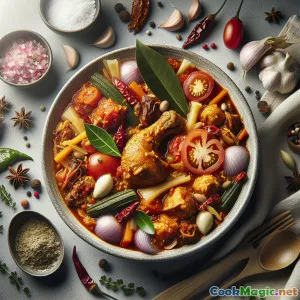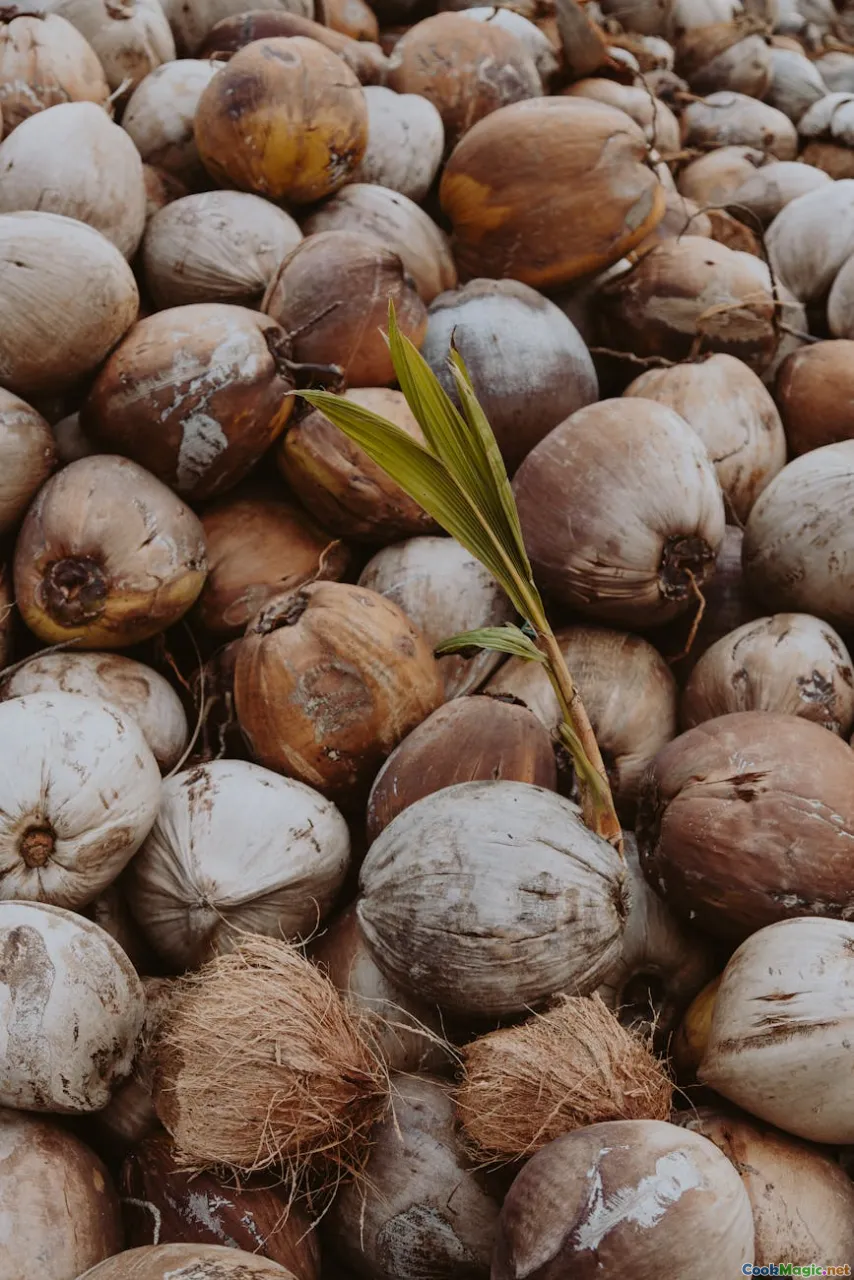
Estufado de frango com noz de dendê ao estilo ganense (Abenkwan)
(Ghanaian Palm Kernel Chicken Stew (Abenkwan))
(0 Avaliações)0
41
novembro 01, 2025
Reportar um problema
Ingredientes
-
800 ml Concentrado de noz de palmiste (creme de palmiste)
(Well-stirred; canned or jarred)
-
1200 grams Frango, pedaços com osso
(Thighs/drumsticks preferred for flavor)
-
1200 ml Caldo de frango ou água
(Adjust for desired thickness)
-
300 grams Cebola picada
(About 2 medium)
-
250 grams tomates frescos, picados
(About 2 medium; or use canned)
-
2 tbsp Extrato de tomate
(Enhances color and depth)
-
1 piece Pimenta Scotch bonnet ou habanero
(Increase to taste; handle with gloves)
-
3 cloves Alho (picado)
(Freshly minced for best aroma)
-
1 tbsp Gengibre fresco, ralado
(Bright, warm spice)
-
100 grams Peixe seco ou defumado, em lascas
(Smoked mackerel or herrings for depth)
-
2 tbsp Lagostim moído (pó de camarão seco)
(Umami booster)
-
1 pod Vagem de Prekese (fruto Aidan)
(Traditional Ghanaian aromatic)
-
2 leaves Folhas de louro
(Subtle herbal aroma)
-
1 tsp Tomilho seco
(For seasoning chicken)
-
1.5 tsp sal grosso fino do mar
(Ajuste a gosto)
-
0.5 tsp Pimenta-do-reino moída
(Seasoning base)
-
100 grams Quiabo, fatiado
(Light natural thickener)
-
10 grams Folhas de manjericão fresco ou folhas de berinjela do jardim, cortadas em tiras
(Fragrant finish)
-
1 tbsp Óleo de palma
(Optional for richer color if needed)
(Well-stirred; canned or jarred)
(Thighs/drumsticks preferred for flavor)
(Adjust for desired thickness)
(About 2 medium)
(About 2 medium; or use canned)
(Enhances color and depth)
(Increase to taste; handle with gloves)
(Freshly minced for best aroma)
(Bright, warm spice)
(Smoked mackerel or herrings for depth)
(Umami booster)
(Traditional Ghanaian aromatic)
(Subtle herbal aroma)
(For seasoning chicken)
(Ajuste a gosto)
(Seasoning base)
(Light natural thickener)
(Fragrant finish)
(Optional for richer color if needed)
Nutrição
- Porções: 6
- Tamanho da Porção: 1 tigela (350g)
- Calories: 650 kcal
- Carbohydrates: 14 g
- Protein: 35 g
- Fat: 48 g
- Fiber: 3 g
- Sugar: 5 g
- Sodium: 900 mg
- Cholesterol: 110 mg
- Calcium: 60 mg
- Iron: 3.5 mg
Instruções
-
1 - Marinate the Chicken:
Pat chicken dry. Season with salt, black pepper, garlic, ginger, and thyme. Toss well and let sit while you prep the aromatics.
-
2 - Prep aromatics and chilies:
Chop onions and tomatoes. Finely chop or pierce the scotch bonnet (for less heat, leave whole to remove later). Rinse prekese pod if using.
-
3 - Sear the Chicken:
Heat a heavy pot over medium-high. Add a thin film of oil if needed. Brown chicken in batches 2–3 minutes per side to build fond; set aside.
-
4 - Sweat onions and tomato paste:
Lower heat to medium. Add onions; cook until translucent. Stir in tomato paste and fry 1–2 minutes until brick-red and fragrant.
-
5 - Add tomatoes and aromatics:
Stir in chopped tomatoes and scotch bonnet. Cook until tomatoes soften and release juices, about 3–4 minutes.
-
6 - Build the Stew Base:
Return chicken to the pot with any juices. Add stock/water, bay leaves, and prekese if using. Bring to a gentle boil.
-
7 - Incorporate palm nut concentrate:
Stir in palm nut concentrate until evenly combined. Reduce heat to medium-low and simmer, partially covered.
-
8 - Slow simmer for flavor and tenderness:
Simmer 25–35 minutes, stirring occasionally so the concentrate doesn’t catch. Add smoked fish and crayfish halfway through if using. Skim excess foam.
-
9 - Adjust thickness and finish vegetables:
If too thick, add a splash of water; if thin, simmer uncovered. Stir in sliced okra and cook 3–5 minutes until just tender.
-
10 - Season and rest:
Check salt and heat. Add basil or garden egg leaves to wilt. Optionally swirl in 1 tbsp palm oil for color. Rest 5 minutes before serving.
Pat chicken dry. Season with salt, black pepper, garlic, ginger, and thyme. Toss well and let sit while you prep the aromatics.
Chop onions and tomatoes. Finely chop or pierce the scotch bonnet (for less heat, leave whole to remove later). Rinse prekese pod if using.
Heat a heavy pot over medium-high. Add a thin film of oil if needed. Brown chicken in batches 2–3 minutes per side to build fond; set aside.
Lower heat to medium. Add onions; cook until translucent. Stir in tomato paste and fry 1–2 minutes until brick-red and fragrant.
Stir in chopped tomatoes and scotch bonnet. Cook until tomatoes soften and release juices, about 3–4 minutes.
Return chicken to the pot with any juices. Add stock/water, bay leaves, and prekese if using. Bring to a gentle boil.
Stir in palm nut concentrate until evenly combined. Reduce heat to medium-low and simmer, partially covered.
Simmer 25–35 minutes, stirring occasionally so the concentrate doesn’t catch. Add smoked fish and crayfish halfway through if using. Skim excess foam.
If too thick, add a splash of water; if thin, simmer uncovered. Stir in sliced okra and cook 3–5 minutes until just tender.
Check salt and heat. Add basil or garden egg leaves to wilt. Optionally swirl in 1 tbsp palm oil for color. Rest 5 minutes before serving.
Mais sobre: Estufado de frango com noz de dendê ao estilo ganense (Abenkwan)
Palm Kernel Chicken Stew (Abenkwan): Story, Technique, and Tips
Palm Kernel Chicken Stew—known in Ghana as Abenkwan—is a radiant bowl of comfort that celebrates the rich, nutty essence of palm fruit. It’s undeniably lush, pleasantly earthy, and full of layered flavor. In this version, tender bone-in chicken simmers gently in palm nut concentrate with tomatoes, onion, ginger, garlic, and a spirited scotch bonnet pepper. Optional additions like smoked fish, crayfish powder, and the aromatic prekese pod push the stew into unforgettable territory. The result is a glossy, sunset-orange broth that clings to the chicken and begs to be paired with fufu, rice, boiled yam, or ripe plantain.
What Makes This Stew Special
- Depth of flavor from palm kernel: Palm nut concentrate isn’t the same as plain palm oil. It’s extracted from the fruit pulp, bringing tang, nuttiness, and natural emulsifiers. As it simmers, you’ll notice a signature sheen and body develop in the pot.
- Gentle heat, big perfume: Even one scotch bonnet lends fragrant warmth without overwhelming the dish. For milder heat, leave the pepper whole and remove it at the end.
- Traditional aromatics: The trifecta of onion, ginger, and garlic is foundational in Ghanaian kitchens. Add tomato paste to concentrate sweetness and color; fresh tomatoes brighten the stew’s acidity.
- Optional umami boosters: Smoked fish and crayfish powder introduce a fireside savoriness reminiscent of coastal smokehouses. A single prekese pod lends sweet, anise-like notes.
Techniques for Success
- Build a flavorful base: Briefly browning the chicken creates fond—a caramelized layer that enriches the stew when deglazed with stock. Don’t skip it.
- Fry the tomato paste: Cooking the paste until brick-red removes its tinny edge and unlocks deep sweetness.
- Simmer patiently: Palm nut concentrate thickens and separates as it cooks. A steady, low simmer helps the oil rise and the flavors meld without scorching.
- Balance the body: Adjust thickness with stock or water. Okra offers a subtle, natural viscosity without turning the stew gelatinous.
- Rest the stew: Five minutes off-heat allows the flavors to settle and the surface oil to redistribute, making the mouthfeel luxurious rather than heavy.
Serving Ideas
- Classic: Ladle over fufu for a traditional Ghanaian experience.
- Weeknight-friendly: Spoon alongside fragrant jasmine or basmati rice.
- Starchy comfort: Serve with boiled yam, cassava, or sweet ripe plantain.
- Fresh finish: A handful of shredded basil or garden egg leaves adds freshness against the stew’s richness.
Ingredient Notes and Swaps
- Palm nut concentrate: Look for canned or jarred versions labeled palm kernel/palm nut cream. If unavailable, some African groceries carry frozen palm fruit pulp. Avoid substituting straight palm oil; the flavor and body are different.
- Chicken choices: Bone-in thighs and drumsticks provide stock-like richness. For leaner eating, use bone-in breasts and shorten the simmer slightly to prevent dryness.
- Heat control: Scotch bonnet has floral heat. Substitute with fresh habanero, or use milder chilies plus a pinch of cayenne.
- Seafood accents: Smoked fish and crayfish are traditional but optional. They add complexity; omit for a purely chicken-forward profile.
- Prekese: A uniquely Ghanaian aromatic (Aidan fruit) with gentle sweetness. If you don’t have it, add an extra bay leaf and a star anise for a complementary nudge.
Make-Ahead, Storage, and Reheating
- Make-ahead: The stew tastes even better the next day. Chill and let the surface oil solidify; you can lift some off to lighten the dish.
- Storage: Refrigerate up to 4 days or freeze in portions for up to 3 months. Thaw overnight in the fridge.
- Reheat: Warm gently over medium-low heat with a splash of water to loosen. Adjust salt after reheating.
Cultural Context
Abenkwan is cherished across Ghana, especially among the Akan people. It’s a celebratory soup that appears at family gatherings, weekend feasts, and festive occasions. While Nigeria’s Banga stew shares palm fruit roots, Ghanaian versions often lean into chicken, prekese, and a balanced tomato-ginger profile. Each region—and every household—stamps its identity on the pot. That variability is part of the dish’s beauty and longevity.
Nutrition and Considerations
Palm fruit lends healthy carotenoids and vitamin E compounds, but it’s also rich in saturated fat. Enjoy in sensible portions and pair with fiber-rich sides like okra, garden eggs, or leafy greens. As with many traditional stews, sodium and fat are adjustable—use homemade low-salt stock and skim some surface oil to suit your goals.
Sustainability Note
If you’re mindful about palm-derived products, source palm nut concentrate from producers committed to sustainable practices. Many African diaspora groceries now carry brands with responsible sourcing statements.
Final Thoughts
Palm Kernel Chicken Stew is the kind of recipe that builds community—its aroma announces something special long before it reaches the table. Whether you serve it with fufu or a simple bowl of rice, you’ll get a spoonful of Ghana’s culinary heritage in every bite: rich, bright, comforting, and unapologetically satisfying.
















